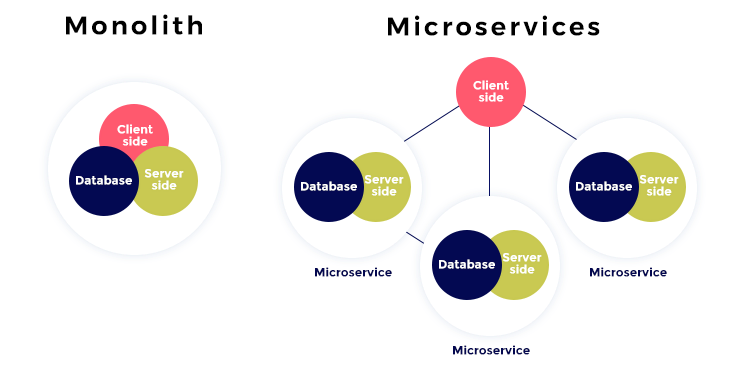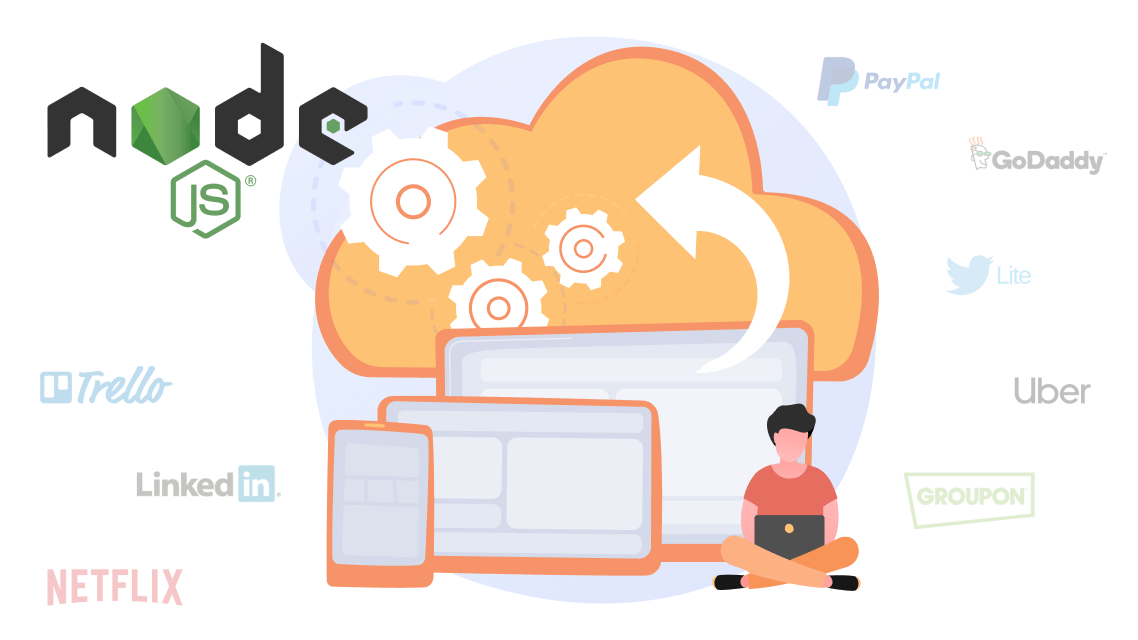Fast, simple, easy, powerful, and flexible - these are the words developers use to describe Node.js apps. This technology is internationally popular because it can solve both current and predicted business and user needs. That is why world-leading companies are using Node.js - and you also have a chance to develop a market-dominating project with its help.
In this article, we have collected a list of the most prominent apps powered by Node.js and described what business problems can be solved with its help.
Main types of apps to build with Node.js
One of the main features of Node.js is its event-driven approach. The growing popularity of interactive applications, social networks, and teamwork solutions led to the growing popularity of Node.js. Here is what you can create with it.
Single-page applications
The single-page app (SPA) is a lightweight web application that consists of one page only. For example, Gmail or Twitter are SPAs. All the content is downloaded upon initial load, that's why it takes a bit longer than usual. However, this enables the app to respond instantly to all user actions - there's no more need to connect to the server.
This is how Gmail and Twitter work.
Single-page applications adjust to any platform and any screen size. Besides, they can also work offline.
SPAs are usually running on JavaScript: Angular, React, or Vue framework on frontend and Node.js on backend.
Real-time applications
The essence of real-time applications is clear from the name - this is an application that instantly responds to a user action, for example, chats or games.
Node.js is scalable, and it allows handling a large number of real-time users. The main advantage of Node.js is its asynchrony, combined with an event approach. The ability to perform several requests simultaneously makes Node.js a perfect choice for real-time apps.
Node.js application for IoT devices
Why are IoT applications so special? Due to a huge amount of data constantly generated by connected sensors, engines, cameras, such an application should be able to process and store. Node.js is suitable for data-intensive apps with large real-time traffic.
Location-based apps powered by Node.js
In 2023, most of the popular applications provide location-based services. And a huge number of them is also developed using Node.js. Asynchrony and the ability to provide real-time updates are the main advantages of Node.js for this type of application.
Node.js streaming application
Node.js can easily handle real-time data streams, which is the main idea of streaming applications. Moreover, Node.js can provide quick data synchronization between the server and the client. As a result, users get an improved experience because of a minimized delay.
What is more, it is possible to combine the best features of Node.js in one application. For example, knowing that this platform is ideal for the Internet of things, streaming, and real-time applications, it is possible to use it to create drone-streaming Node.js app examples.
Best Node.js Projects With World-Famous Names
Each of the Node.js App Examples we are going to list employed one of the best Node.js qualities - and got measurable and positive results.
Trendsetting apps use Node.js for the obvious reasons - it's the ability to withstand great loads and serve a large number of users. Isn't it what the industry leaders expect?
Groupon - 50% reduction in page loading time
Groupon is a kind of aggregator that collects discounts for different goods and services in one place. Initially, it based on Ruby on Rails. After a few acquisitions, PHP and Java were added to the stack. The product was growing, and it became hard to maintain. Groupon was looking for a solution to unify all services with a single technology. And Node.js seemed to be the right choice.
The migration process took almost a year. Today, this is a platform with 50% faster page loads since a single server processes all operations. Also, Node.js made the web app more stable: before the migration, Groupon released an attractive Starbucks deal, it was so popular that the website went down. This never happened to a Node.js powered Groupon website, even though there were more popular deals offered.
Twitter Lite - speedy and powerful progressive web application
Twitter has a goal - to reach every person on the planet, but slow, unreliable, or expensive Internet connection in many regions made this goal hard to achieve. But then the solution was found: Twitter Lite - a progressive web application.
A PWA with React on frontend and Node.js on backend made Twitter accessible for everyone: the app works in any browser on any device (no restrictions to just Android and iOS smartphones). The Service Worker caches the content and makes app usage possible even when the connection is lost. Once the Internet is available again, new content is downloaded and stored in the cache.
The creators managed to make the application lighter but, at the same time, powerful. The initial app load takes up to 5 seconds in slow 3G networks, and this is also a great result.
GoDaddy - 10x fewer servers
GoDaddy is one of the largest web hosting companies worldwide. Currently, it has over 77 million registered domains, which is around 20% of the world's total. Just imagine the number of visitors, GoDaddy has to serve daily.
The service was initially powered by .Net, which limits you to monolithic architecture. Looking for ways to switch to modularity, the GoDaddy team has chosen Node.js - a technology supported by a strong community of module publishers.
Currently, almost the whole team consists of full-stack JavaScript developers who can work both on frontend and backend. Also, the transition to microservices architecture enabled to reduce the deployment time to under one minute. Vibrant result!
Also, in 2016, the GoDaddy Website Builder platform was ported to Node.js. One of the changes was the migration to the Cassandra database. As a result, the number of servers required to host the websites reduced by 10 times.
Uber - One of the first 3 companies to use Node.js in the development
Uber was one of the first companies in innovative taxi services - and one of the first who used Node.js in production. The main reason for this choice was the already mentioned asynchrony, the ability to process large amounts of data almost instantly, clean code, and the cost to implement it.
What is more, the essence of this app is the driver-passenger matching system. They needed the event-driven environment, short but powerful code, and the ability to withstand huge loads. These are the features Node.js can offer simultaneously. For now, Uber can withstand 2 million real-time calls per second.
Sharing JavaScript on frontend and backend made it possible to build a universal (isomorphic) web application for Uber users.
LinkedIn - Node-based server-side of their mobile app
LinkedIn does not need any introductions. As most of the apps from this list, they faced the rising number of mobile users and decided to update the mobile server with Node.js (previously, it based on Ruby-on-Rails). As a result, the new LinkedIn mobile app can handle twice as much traffic with just four instances, instead of 15 required before the migration.
Another requirement for the mobile application was seamless work with the platform API and database. In terms of performance, Node.js outplayed the former Ruby on Rails backend.
Trello - Simple Agile interface at fingertips
Trello is now one of the most popular project management tools for Agile teams. Its intuitive interface and real-time changes in task management attract companies from a variety of industries as well as individuals. Node.js is the core technology for Trello from day one. Initially, the team was about to build a single-page application prototype and chose Node.js due to the fast development process and code reusability.
But Node.js could handle more complex tasks as well. Trello's functionality looks simple for the user, but there are tons of work handled by the server. Also important are the real-time updates - a feature that is perfectly implemented with the help of Node.js event-driven approach.
Netflix - transfer from a monolith app to distributed instances
When you hear the word "streaming," you most likely think of Netflix. This company went from a DVD shop to the world's largest streaming service and its own production. How do they serve millions of users simultaneously?
With a sleek combination of Java and Node.js on the backend. All APIs for different platforms (including iOS and Android, desktop operating systems, and various TV platforms) were previously run by a monolith Groovy app. Node.js enabled to build restify instances and run them in separate Docker containers. As a result, the apps are faster and more scalable with better versioning. The development time was also greatly reduced.
PayPal - 200ms faster-served pages
PayPal's journey to Node.js started with an experiment: two backend teams had to develop the same app prototype. The Java team consisted of 5 developers, whereas in the team Node.js were only two developers. Surprisingly, the Node team outplayed the competitor and has proven that this technology enables faster development. This is how Node.js became a part of PayPal's core stack.
As a result, PayPal is capable of processing twice as many user requests per second, and the response from the page has 34% faster, which is 200 ms on average. PayPal payment system is also on the list of the most used financial applications for iPhone, and at the moment, it serves 286 million financial accounts worldwide.
Node.js Application Developed by Clockwise
The great potential of technology does not mean that only giant corporations can use it for development. What is more, startups often hire Node.js development company to build a scalable application in short terms. This technology is also perfectly suitable for small and medium-sized businesses. And here is a Node.js app example created by our team.
Fleet Management Software
This platform began as software that connects waste truck drivers and dispatchers. At the moment, this is a multifunctional mobile application that can be used by any company that coordinates transport and people.
This is exactly the case when an application benefits from several Node.js benefits at once.
- Real-time changes
Before application development, drivers and dispatchers used phone calls or face-to-face meetings for communication. This reduced efficiency and increased the likelihood of mistakes. With the fleet management app, all the procedures are automated: drivers get instant notifications when dispatchers make changes to order status, and all work processes are easily tracked.
- Fast load time
This is a problem similar to that of Groupon or PayPal - and Node.js brought a perfect solution. In our app, we managed to reduce the load time from 5 to 1.5 seconds.
Technical Reasons Why Startups Choose Node.js
We have already discussed the most prominent Node.js app examples and showed that this technology is able to solve various business tasks - from development time reduction to improved user experience. However, there are some more reasons to choose it.
Usability
Node.js is just the case when you do not need to reinvent the wheel. Consequently, it increases development speed, and less code needs to be created. What is more, the Node.js web application development cycle can be optimized even better with the help of tools and technologies available inside the Node Package Manager (NPM).
Microservices
PayPal and Netflix use this approach. Node.js is perfectly suitable for microservices architecture development because it perfectly fits the event-driven I/O model.
In practice, this means that each user request is addressed to a certain part of an app and gets a response directly from it.

Faster development process
When compared to its closes rival Java, Node.js as a core backend technology has clear benefits:
- Twice less time needed to develop the same amount of functionality
- 33% fewer lines of code needed
- 40% fewer files
Node.js is capable of giving you more than you expect. If you are planning to create an interactive application that could potentially have a broad target audience, a large number of queries, and dynamic data, then Node.js would be the right choice.


